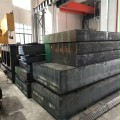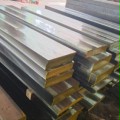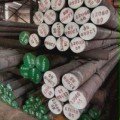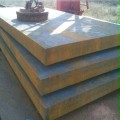Detailed Introduction
Model : 1.2344 /H13 /4Cr5MoSiV / X40CrMoV5-1 / 40CrMoV5 / 4X5MΦC
Application : hot working tool steel
Content : Equivalent Steel with exact or nearest equivalents
|
Grade |
C |
Si |
Mn |
P |
S |
Cr |
V |
Mo |
|
1.2344 |
0.35-0.42 |
0.80-1.20 |
0.25-0.50 |
≤0.03 |
≤0.03 |
4.80-5.20 |
0.85-1.15 |
1.20-1.50 |
|
Grade |
C |
Si |
Mn |
P |
S |
Cr |
V |
Mo |
|
H13 |
0.32-0.45 |
0.80-1.25 |
0.20-0.60 |
≤0.03 |
≤0.03 |
4.75-5.50 |
0.80-1.20 |
1.10-1.75 |
|
Grade |
C |
Si |
Mn |
P |
S |
Cr |
V |
Mo |
|
4Cr5MoSiV |
0.33-0.43 |
0.80-1.20 |
0.20-0.50 |
≤0.03 |
≤0.03 |
4.75-5.50 |
0.30-0.60 |
1.10-1.60 |
|
Grade |
C |
Si |
Mn |
P |
S |
Cr |
V |
Mo |
|
X40CrMoV5-1 |
0.35-0.42 |
0.80-1.20 |
0.25-0.50 |
≤0.03 |
≤0.03 |
4.80-5.20 |
0.85-1.15 |
1.20-1.50 |
H13 Description :
H13 steel generally used to manufacture forging dies, hot extrusion dies, precision forging dies with high impact load; die-casting dies for aluminum, copper and their alloys.H13 steel is hot work die steel.
The unified digital code is A20502; the brand is 4Cr5MoSiV1; H13 steel is a steel grade formed by adding alloy elements on the basis of carbon steel.
Electroslag heavy capacity steel, the steel has high harden-ability and thermal crack resistance, the steel contains a higher content of carbon and vanadium, good wear resistance, relatively weakened toughness, and has good heat resistance.
At higher temperatures, it has better strength and hardness, high wear resistance and toughness, excellent comprehensive mechanical properties and high tempering resistance stability.
The carbon content of the steel determines the hardness of the hardened steel.
According to the relationship curve between the carbon content of the steel and the hardness of the quenched steel, it can be known that the quenching hardness of H13 steel is about 55HRC. For tool steel, part of the carbon in the steel enters the steel matrix to cause solid solution strengthening.
Another part of carbon will combine with carbide forming elements in alloying elements to form alloy carbides. For hot work die steels, in addition to a small amount of residual carbides, this alloy carbide is required to be dispersed and precipitated on the quenched martensite matrix during the tempering process to produce two hardening phenomena.
Therefore, the uniform distribution of residual alloy carbon compounds and tempered martensite determines the performance of hot work die steel. It can be seen that the C content in steel cannot be too low.
Heat treatment:
l Quenching: 790 degrees +/ -15 degrees preheating
l 1000 degrees (salt bath) or 1010 degrees (furnace control atmosphere) +-6 degrees heating
l Insulation 5~15min air cooling
l 550 degrees +-6 degrees tempering annealing, thermal processing;
l Plastic molds can be processed to HRC48-52 degrees, and die-casting molds can be processed to HRC42-46.
Heat treatment process:
1. Pre-heating treatment:
The H13 steel and die blanks available on the market have been annealed and heat-treated in the steel plant to ensure that they have a good metallographic structure, appropriate hardness, and good work-ability, and no annealing is required. However, the original structure and performance were destroyed after the forging by the manufacturer, and the forging stress was increased, and re-annealing was necessary.
The isothermal spheroidizing annealing process is: 860~890℃ heating and holding for 2h, cooling to 740~760℃ isothermal 4h, and furnace cooling to about 500℃.
2. Quenching process specifications for molds with good toughness required for quenching and tempering: heating temperature 1020~1050°C, oil cooling or air cooling, hardness 54~58HRC; mold quenching process specifications that require thermal hardness, heating temperature 1050~1080°C, Oil cooling, hardness 56~58HRC.Recommended tempering temperature: 530~560℃, hardness 48~52HRC; tempering temperature 560~580℃; hardness 47~49HRC.
Tempering should be carried out twice. When tempered at 500°C, the secondary hardening peak of tempering appears, the tempering hardness is the highest, the peak is around 55HRC, but the toughness is the worst. Therefore, the tempering process should avoid about 500 ℃. According to the needs of the mold, it is better to temper in the range of 540~620℃.
Quenching heating should be preheated twice (600~650℃, 800~850℃) to reduce thermal stress during heating.
3. Chemical heat treatment of H13 steel if gas nitriding or nitrocarburizing can further strengthen the mold, but its nitriding temperature should not be higher than the tempering temperature to ensure that the strength of the core does not decrease, thereby increasing the service life of the mold.
H13 steel Chemical composition analysis:
H13 steel is C-Cr-Mo-Si-V steel, which is widely used in the world. At the same time, many scholars from various countries have conducted extensive research on it and are exploring the improvement of chemical composition.
H13 steel is widely used and has excellent characteristics, mainly determined by the chemical composition of steel. Of course, the impurity elements in the steel must be reduced. Some data show that when the Rm is 1550MPa, the sulfur content of the material is reduced from 0.005% to 0.003%, which will increase the impact toughness by about 13J. Obviously, the NADCA 207-2003 standard stipulates that the sulfur content of premium H13 steel should be less than 0.005%, while the sulfur content of superior should be less than 0.003%S and 0.015%P.
Carbon: American AISI H13, UNS T20813, ASTM (the latest version) H13 and FED QQ-T-570 H13 steel have a carbon content of (0.32~0.45)%, which is the most carbon content of all H13 steels. Wide.
The carbon content of German X40CrMoV5-1 and 1.2344 is (0.37~0.43)%, and the carbon content range is narrow. In German DIN17350, the carbon content of X38CrMoV5-1 is (0.36~0.42)%.
The carbon content of SKD 61 in Japan is (0.32~0.42)%. The carbon content of 4Cr5MoSiV1 and SM 4Cr5MoSiV1 in my country's GB/T 1299 and YB/T 094 is (0.32~0.42)% and (0.32~0.45)%, which are the same as SKD61 and AISI H13, respectively. In particular, the carbon content of H13 steel in the North American Die Casting Association NADCA 207-90, 207-97 and 207-2003 standards is specified as (0.37~0.42)%. H13 steel containing 5% Cr should have high toughness, so its C content should be maintained at a level that forms a small amount of alloy C compounds.
As we all know, increasing the carbon content in steel will increase the strength of the steel.
For hot work die steel, it will increase the high temperature strength, hot hardness and wear resistance, but will lead to a decrease in its toughness.
The comparison of the properties of various H-section steels in the tool steel product manual documents clearly proves this view. It is generally believed that the carbon content limit that leads to the reduction of steel ductility and toughness is 0.4%.
For this reason, people are required to follow the following principles in the design of steel alloying: the carbon content of steel should be reduced as much as possible under the premise of maintaining strength. Some data has been proposed: when the tensile strength of steel reaches 1550 MPa or more, the C content is 0.3 %-0.4% is appropriate. The strength Rm of H13 steel is described in the literature as 1503.1MPa (at 46HRC) and 1937.5MPa (at 51HRC).
For hot work die steels that require higher strength, the method used is to increase the Mo content or increase the carbon content on the basis of the H13 steel composition.
This will be discussed later. Of course, the toughness and plasticity can be slightly reduced.
Chromium: Chromium is the most commonly contained and inexpensive alloy element in alloy tool steel. The Cr content in H-type hot work die steel in the United States is in the range of 2% to 12%. Among the 37 steel grades of alloy tool steel (GB/T1299) in my country, all except 8CrSi and 9Mn2V contain Cr. Chromium has a beneficial effect on the wear resistance, high temperature strength, hot hardness, toughness and harden-ability of steel.
At the same time, when it is dissolved in the matrix, it will significantly improve the corrosion resistance of steel. In H13 steel, Cr and Si densifies the oxide film to improve the oxidation resistance of steel.
Then analyze the effect of Cr on the tempering performance of 0.3C-1Mn steel. The addition of <6% Cr is beneficial to improve the tempering resistance of steel, but it fails to form secondary hardening; when steel containing Cr>6% is quenched After tempering at 550°C, a secondary hardening effect will occur. People generally choose 5% chromium for hot work steel die steel.
Part of the chromium in tool steel is dissolved in the steel for solid solution strengthening, and the other part is combined with carbon. According to the chromium content, it exists in the form of (FeCr)3C, (FeCr)7C3 and M23C6, thereby affecting the performance of the steel. In addition, the interaction effects of alloying elements should also be considered. For example, when the steel contains chromium, molybdenum and vanadium, when Cr>3%[14], Cr can prevent the formation of V4C3 and delay the co-existence of Mo2C. V4C3 and Mo2C are strengthening phases that improve the high-temperature strength and tempering resistance of the steel. This interaction improves the heat-resistant deformation performance of the steel.
Chromium dissolves into steel austenite to increase the harden-ability of steel. Cr, Mn, Mo, Si, and Ni are all alloying elements that increase the harden-ability of steel like Cr. People are accustomed to use the harden-ability factor to characterize. Generally, the existing domestic data [15] only use the data of Grossmann and others. Later, the further work of Moser and Legat [16, 22] proposed that the C content and the austenite grain The degree determines the basic harden-ability diameter Dic and the harden-ability factor determined by the alloying element content (shown in Figure 3) to calculate the ideal critical diameter Di of the alloy steel, which can also be approximated from the following formula: Di=Dic×2.21Mn ×1.40Si×2.13Cr×3.275Mo×1.47Ni (1) (1) In the formula, each alloy element is expressed in mass percentage.
From this formula, people have a clear semi-quantitative understanding of the effects of Cr, Mn, Mo, Si and Ni on the harden-ability of steel.
The effect of Cr on the eutectoid point of steel is roughly similar to that of Mn. When the chromium content is about 5%, the C content of the eutectoid point drops to about 0.5%. In addition, the addition of Si, W, Mo, V, and Ti can significantly reduce the C content at the eutectoid point. For this reason, it can be known that hot work die steel and high-speed steel belong to hypereutectoid steel. The decrease of the eutectoid C content will increase the alloy carbide content in the structure after austenitization and in the final structure.
The behavior of alloy C compound in steel is related to its own stability. In fact, the structure and stability of alloy C compound are related to the degree of electron deficiency in the d electron shell and S electron shell of the corresponding C compound forming element. As the degree of electron deficiency decreases, the atomic radius of the metal decreases, and the atomic radius ratio of carbon and metal elements increases, and the alloy C compound changes from the interstitial phase to the interstitial compound.
The stability of the C compound weakens, and the corresponding melting temperature and The dissolution temperature in A decreases, the absolute value of its free energy of formation decreases, and the corresponding hardness value decreases. The VC carbide with face-centered cubic lattice has high stability. It starts to dissolve at a temperature of about 900~950℃, and it dissolves in a large amount above 1100℃ (the end temperature of dissolution is 1413℃); it is tempered at 500~700℃ Precipitating in the medium, it is not easy to aggregate and grow up, and can be used as a strengthening phase in steel. The M2C and MC carbides formed by the medium carbide forming elements W and Mo have close-packed and simple hexagonal lattices.
Their stability is less, and they also have higher hardness, melting point and dissolution temperature. They can still be used at 500~ The strengthening phase of steel is used in the range of 650°C. M23C6 (such as Cr23C6, etc.) has a complex cubic lattice, poorer stability, weaker bonding strength, lower melting point and melting temperature (dissolved in A at 1090°C), only after comprehensive alloying in a few heat-resistant steels It has higher stability (such as (CrFeMoW)23C6), which can be used as a strengthening phase. M7C3 with a complex hexagonal structure (such as Cr7C3, Fe4Cr3C3 or Fe2Cr5C3) has worse stability, and it is as easy to dissolve and precipitate as Fe3C carbides , Has a large accumulation and growth rate, generally cannot be used as a high-temperature strengthening phase.
Solar Special Steel International Limited
Contact Person :Wendy
Telephone:+86 18688633122 whatsapp&wechat
Skype: .cid.8920082fecfa0b5c
Email:ss@solarsteel.cn








